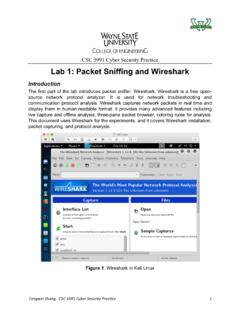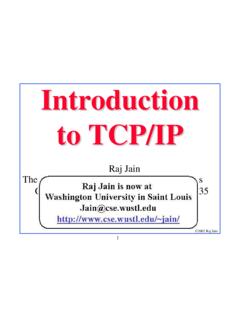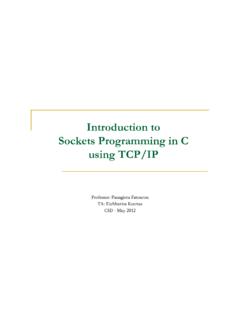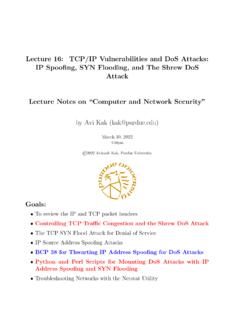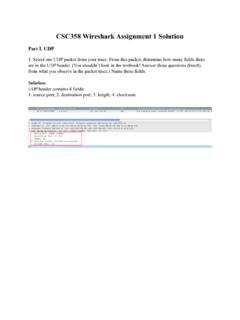Transcription of Ethernet Theory of Operation
1 2008 Microchip Technology 1AN1120 INTRODUCTIONThis document specifies the Theory and Operation ofthe Ethernet technology found in PIC MCUs withintegrated Ethernet and in stand-alone Ethernetcontrollers. Ethernet technology contains acronyms and termsdefined in Table is an asynchronous Carrier Sense MultipleAccess with Collision Detect (CSMA/CD)protocol/interface, with a payload size of 46-1500 data rates of tens to hundreds of megabits/second,it is generally not well suited for low-power , with ubiquitous deployment, internetconnectivity, high data rates and limitless rangeexpansibility, Ethernet can accommodate nearly allwired communications requirements.
2 Potentialapplications include: Remote sensing and monitoring Remote command, control and firmware updating Bulk data transfer Live streaming audio, video and media Public data acquisition (date/time, stock quotes, news releases, etc.) Theory OF OPERATIONE thernet is a data link and physical layer protocoldefined by the IEEE specification. It comes inmany flavors, defined by maximum bit rate, mode oftransmission and physical transmission medium. Maximum Bit Rate (Mbits/s): 10, 100, 1000, etc. Mode of Transmission: Broadband, Baseband Physical Transmission Medium: Coax, Fiber, UTP, :M. Simmons Microchip Technology Inc.
3 TABLE 1: Ethernet GLOSSARYTermDefinitionCRCC yclic Redundancy Check: Type of checksum algorithm used when computing the FCS for all Ethernet frames and the hash table key for hash table filtering of receive Address: The 6-octet destination address field of an Ethernet Delimiter: In 100 Mb/s Operation , the ESD is transmitted after the FCS (during the inter-frame gap) to denote the end of the Check Sequence: The 4-octet field at the end of an Ethernet frame that holds the error detection checksum for that Protocol: Refers either to IPv4 or Area Network or Large Area Network. MACM edia Access Control: The block responsible for implementing the Media Access Control functions of the Ethernet AddressA 6-octet number representing the physical address of the node(s) on an Ethernet network.
4 Every Ethernet frame contains both a source and destination address, both of which are MAC Dependent Interface or Management Data Input. MDOM anagement Data Output. MDIOM anagement Data Independent Interface: Standard 4-bit interface between the MAC and the PHY for communicating TX and RX frame data. In 10 Mb/s mode, the MII runs at MHz; in 100 Mb/s mode, it runs at 25 Management: Set of MII sideband signals used for accessing the PHY Theory of OperationAN1120DS01120A-page 2 2008 Microchip Technology Unique Identifier: The upper three octets of a MAC address are referred to as the OUI, and typically are assigned to an organization or company.
5 Microchip s OUI is Ethernet terms, one 8-bit BufferThe physical or virtual memory where all transmit and receive packets (frames) are block that implements the Ethernet physical Access Memory (normally volatile memory).Receive BufferLogical portion of the packet buffer used to store received SASource Address: The 6-octet source address field of an Ethernet Frame Delimiter: The single octet field of an Ethernet frame that marks the start of a Peripheral Interface. SSDS tart-of-Stream Delimiter: In 100 Mb/s Ethernet , the first octet of the preamble is known as the SSD and is encoded differently from the rest of the AddressThe Station Address is the MAC address of the Ethernet node.
6 It is typically compared against the destination address in a received Ethernet frame to determine if the frame should be received or not. On the transmit side, it is typically transmitted as the source address of an Ethernet frame. Transmit BufferLogical portion of the packet buffer used to store packets to be Media Independent Interface: A 2-bit version of the Media Independent Interface: A 1-bit version of the Inverted: A binary code in which a logical one is represented by a signal transition and a logical zero is represented by the lack of a 1: Ethernet GLOSSARY (CONTINUED)TermDefinition 2008 Microchip Technology 3AN1120 PROTOCOL STACKThe easiest way to understand the role that Ethernetplays is by looking at a protocol stack, which describesa complete protocol or set of protocols in a layeredapproach (see Figure 1).
7 Frame/Packet EncapsulationTo understand how Ethernet works, it is first necessaryto understand the concept of packet encapsulation,and how the protocol stack fits into this layer of the protocol stack is responsible for aparticular level of functionality. As an example, thephysical layer is concerned with the actual electricaltransmission of bits across a medium. Each higherlayer in the model utilizes the underlying layers in asomewhat independent fashion (meaning little or nooverlap in functions between the layers).This layered approach is implemented through the useof encapsulation. This concept can best be explainedusing the example shown in Figure 2.
8 This exampleshows how each layer associated with a web browsersession maps to the protocol stack at the application layer, the web browser wouldgenerate an HTTP request using anapplication-specific command. This request would thenbe passed down to the TCP layer, which wouldconstruct a TCP packet consisting of a TCP headerand TCP data. The TCP header contains informationparticular to the TCP protocol, such as packetsequencing information, checksum information and thesource and destination port number (HTTP typicallyhas a port number of 80).At the IP protocol level, an IP datagram is constructedto hold the TCP packet.
9 Similar to the TCP packet, theIP datagram consists of an IP header and IP data. TheIP header contains information such as the type ofservice, checksum information, protocol type (06h forTCP), and the source and destination IP data field of the IP datagram contains the completeTCP packet to be the data link/physical layer, the IP datagram is trans-ported across the network using the IEEE A MAC (IEEE ) frame consists of a MACheader and a MAC payload (data). The MAC headercontains information about the MAC frame, such as thesource MAC address, the destination MAC addressand the length of the frame.
10 The payload field containsthe complete IP datagram to be that the various addresses encapsulated withineach protocol are different, and typically, have no fixedrelationship to one another. In our example, the TCPpacket uses a port number, which is typically assignedbased on the application layer protocol ( , port 80 forHTTP). The IP datagram uses an IP address, which isstatically or dynamically assigned out of a pool of avail-able internet addresses, and the MAC frame uses MACaddresses, which are assigned to the particular pieceof 1:INTERNET PROTOCOL STACK Note 1:The terms MAC frame , Ethernet frame and IEEE frame are usedinterchangeably in this.











